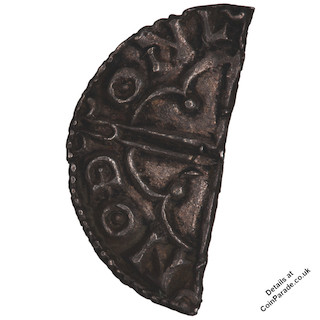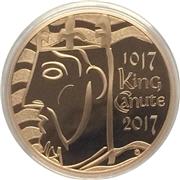
 Lincoln Mint Reverse MV.jpg) The 1017 Halfpenny King Cnut (Canute) Lincoln Mint
The 1017 Halfpenny King Cnut (Canute) Lincoln MintAlthough the halfpenny coin wasn't introduced until 1672, halfpennies were in circulation much earlier as 'cut' coins, literally a penny coin cut in half. To help cut the coin correctly, the reverse often had a cross design which also allowed the coin to be cut into quarters.
This coin of the Anglo-Saxon King Cnut (often known as King Canute) was cut from a penny with a 'voided' long cross (the cross had 2 lines with a gap in between to facilitate cutting). The penny was a quatrefoil type showing a crowned bust (SCBC 1157. It was struck between 1017-1023 at the Lincoln mint of moneyer Aelfnoth.
The Reverse shows the remains of the voided long cross, legend "NOD ON L:.
 Lincoln Mint Obverse MV.jpg) The Obverse shows the back of a crowned bust facing left within a quatrefoil. Legend around: "CNVT REX".
The Obverse shows the back of a crowned bust facing left within a quatrefoil. Legend around: "CNVT REX".Image credit: Museums Victoria
Mintage: Not known
Minted at Provincial mints
More information (monarch, year, mint, country, category) can be found below coin listings.
Below are some coins currently being offered on eBay. As an eBay Partner, We may be compensated if you make a purchase.
List items on:
List items on:
Canute (Cnut) (1016-1035)
 Classification: ANGLO-SAXON, Kings of All England.
Classification: ANGLO-SAXON, Kings of All England.King Cnut the Great, better known to many as King Canute, was King of Denmark, England, and Norway. He was born about 995 and died in 1035. Cnut was King of England 1016–1035.
Early Life
Cnut’s father, Sweyn Forkbeard (960-1014) was king of Denmark during 986–1014. He was also the father of King Harald II of Denmark and Queen Estrid Svendsdatter. Cnut’s Mother is uncertain but is believed to be a Polish Princess.
Sweyn, with his son Cnut, invaded England in 1013. Sweyn died the year after. Harald became King Harald II of Denmark and the people of the Danelaw make Cnut as King in England. The English had different ideas and Cnut had to battle Edmund Ironside (son of Ethelred) and several others before eventually taking the throne.
When Harald died, Cnut became King of Denmark in 1019 and King of Norway in 1028.
Although Cnut was a powerful warrior he was also a great Statesman and Anglophile. Cnut paid homage to previous (Anglo-Saxon) Kings, converted to Christianity, supported the Church, travelled to Rome to meet the Holy Emperor and the Pope and was acknowledged by the Pope as the first Viking to become a Christian King. He promised to be a fair King to his Saxon subjects.
Cnut showed humility is often remembered with the story that he sat on the beach and told the sea to 'go back'; he used it to show his flattering courtiers that a King did not possess God-like powers.
Marriage(s)?
When Ethelred II (the Unready) died in 1016, his wife Emma (Emma of Normandy, daughter of Richard I) fled to her home country in Normandy. She returned in 1017 – as Cnut’s wife. This was quite a smart and conciliatory move. However, it appears that Cnut already had a wife, Elgiva (Ælfgifu of Northampton), whom he also had children with.
Although Emma and Elgiva naturally disliked each other, Cnut didn’t abandon his children. Elgiva’s children Sweyn Knutsson became King of Norway and Harold Harefoot became King of England; Emma’s children Harthacnut became King of Denmark and England and her daughter Gunhilda of Denmark married Henry III, Holy Roman Emperor.
Legacy
Cnut died on 12 November 1035. In Denmark he was succeeded by Harthacnut, reigning as Cnut III. England was ruled by Harold Harefoot as Harold I. Both Emma and Elgiva outlived Cnut.
Cnut was an important Anglo-Saxon King (despite being Danish) and as King of Denmark, England and Norway (and part of Sweden) he ruled the North Sea Empire. He was actually a great King although much of his history is diminished by the Norman invasion in 1066.
To commemorate the 1000th anniversary of King Cnut’s ascendence to the English crown in 2017, the Royal Mint struck a gold proof five pounds piece (£5).
Category: Halfpenny
The halfpenny coin was introduced in 1672 and was minted until 1984 when inflation made it almost worthless. Worth half a penny (1/480th of One Pound), it was usually pronounced 'ape-knee'.- Weight: (1860–1967) 5.67 g
- Diameter: (1860–1967) 25.48 mm
- Edge: Plain
- Composition
- (1672–1860) Copper
- (1860–1967) Bronze
Which Mint: Provincial mints
Not all mints are located in a single place. From the Roman days through to the middle ages it was easier to have local moneyers (trusted people who were allowed to mint coins) rather than make the coins centrally and then have the security and logistics problem of distribution.There were often dozens of mints, sometimes all making the same coin. The variations and mintmarks are exciting for numismatists, although sometimes it takes an expert to analyse them.
Most English Provincial Mints began to close after 1279 when the Royal Mint opened The Tower Mint (called so as it was housed at the Tower of London), although some continued working for much longer. The central mint gave the King and the Master of the Royal Mint much more control over the production and quality of English coinage.
Country of Origin: United Kingdom
The United Kingdom (UK) is the Union of England, Scotland, Wales and Northern Ireland. It is often refered to as Great Britain (GBR). It has a long, rich history. The orignal coinage was Pounds, Shillings and Pence but since decimalisation on 15 February 1971, it is £1 = 100p, that is One Pound = 100 pence. The coinage of the UK is also a long history, the Royal Mint being established as long ago as 886AD when coins were hammered. Today there is perhaps 30 billion coins in circulation, and many (numismatic) collectors coins and sets are issued frequently in gold, silver and other metals.







